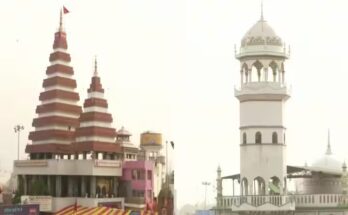
By R Krishna Das
The month of August has a glorious legacy and importance in the Indian history when it comes to national integration and cultural nationalism.
The country gained Independence on 15th August 1947. The August Revolution or the Quit India movement was launched on August 9, 1942 and was one of the reasons for the Britishers’ retreat.
Post Independence, the auspicious Month of August has still relevance. For, Prime Minister Narendra Modi removed a long festering abscess from the Motherland that will be written in golden letters in the history. And the date, ironically, is August 5.
Two events unfolded on August 5 will always be remembered in the history of Modern India for the integration, unity and nationalism. One that took place today with Prime Minister Narendra Modi performing the bhoomipujan for the majestic and marvellous temple of Lord Rama in Ayodhya and another exactly a year ago.
India was divided in 1947 but Article 370 blurred a neat division by preventing the full integration of J&K, the land of Dogras who traced their ancestry to the Ikshvaku (Solar) Dynasty of Northern India—the same clan in which Lord Rama was born. Hence Lord Rama is the ‘kuldevta’ (family deity) of the royal Dogra family.
Ruled by the Hindu dynasty, J&K obtained a special status because of the religious factor. The accession of J&K to India should have ideally led to the full incorporation of J&K into India. As it has claimed time and again, that the Sufi Islam of Kashmir is tolerant by nature, it should have been that much easier to integrate the territory into secular India.
Instead of following that route, India chose to yield to religious compulsions resulting in uncertainties about Kashmir’s future. The revision of Article 370 and Article 35 A and the bifurcation of the state into two Union Territories was a decisive and bold step that is history changing in scope.
Narendra Modi ended the vacillations and dithering of the past by abrogating Article 370 and 35 A in August last year. J&K has been fully integrated with India.
The removal of Article 370 and 35 A was inevitable as the provision was the biggest stumbling block for the national integrity. The term of Jammu and Kashmir Assembly was 6 years and in other States it is for only 5 years. With separate Constitution and flag, RTI act did not applied in old J&K and so were the Central laws.
Hindu and Sikhs minorities were without Minority benefits. Outsiders (Indian Citizens of other States) cannot own or buy land in the state. No private industries could come up in the state due to both the discriminatory articles.
The members of the SuryaVanshi Dogra community have reason to smile. Prime Minister Narendra Modi had not only “integrated” J&K but also started the construction work of Lord Rama in Ayodhya. The Dogra rulers of the erstwhile Jammu Kashmir Ladakh”, on balance, traced their lineage to Lord Rama as they constructed temples dedicated to Raghunath ji and issued coins in his name.
The temple titan in Ayodhya will stands as another symbol of cultural nationalism, integral humanism, national unity and territorial integrity of the nation.



